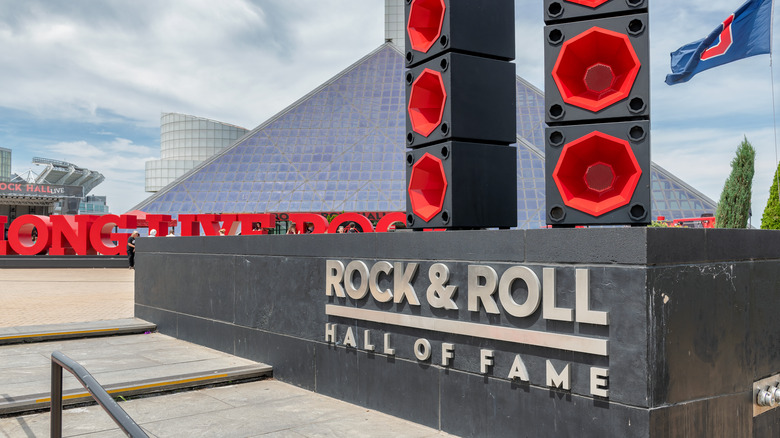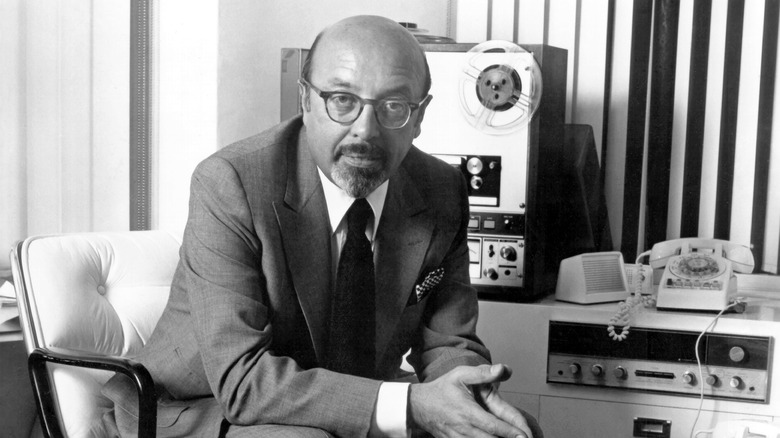Who Founded The Rock & Roll Hall Of Fame?
The Rock & Roll Hall of Fame Foundation has been celebrating the contributions of some of rock music's greatest icons since its founding in 1983. In order to qualify to be inducted, a period of at least 25 years must have passed before consideration by a committee that consists of rock music historians. This committee then takes their picks to be nominated, with the final group of prospective inductees voted on by another body of around 500 rock authorities from around the globe. Finally, the five to seven artists with the highest number of votes are chosen to be included in that year's round of Hall of Fame inductees.
The induction ceremony may only take place over the course of one night, but the featured artists are immortalized in the Rock & Roll Hall of Fame Museum (or Rock Hall) located in Cleveland, Ohio. The museum's vast collection features a variety of exhibits and galleries that take visitors on a trip through rock 'n' roll history. Items on display include instruments and gear used by rock's biggest stars, posters, never-before-seen photographs, stage equipment, and so much more. Because it provides such an immersive experience, the Rock Hall is a must-see location for fans of pop and rock music, and its influence on culture and society. Of course, it only makes sense that such an important institution has a long and storied history.
The origins of the Rock & Roll Hall of Fame
The Rock & Roll Hall of Fame was the brainchild of Ahmet Ertegun, who was the co-founder of Atlantic Records and a producer for various R&B, pop, jazz, and rock artists. As stated in Cleveland Historical, Ertegun, along with other major figures in the music industry, including Rolling Stone Magazine founder Jann Wenner (per Brittanica), established the Rock & Roll Hall of Fame Foundation in 1983. The goal was to build a facility that would recognize the most important artists and groups in rock 'n' roll history, with the initial plan to set it up in Manhattan. At the same time, Hank LoConti, the owner of the Agora Theater in Cleveland, was playing with the idea of building a similar establishment in his hometown because of its deep connections to rock music. He got wind of Ertegun's plan, and so LoConti reached out to Norm N. Nite, a Clevelander with connections to New York City's music scene, to get in contact with Ertegun and present their city as a potential spot for the Rock & Roll Hall of Fame.
Cleveland Historical states that the Foundation visited Cleveland in 1985, and was impressed with the city, but wanted to give other cities a chance to be considered, so a contest was held. While numerous major metropolitan areas with close connections to rock 'n' roll were considered – including San Francisco, Memphis, and New York City— Cleveland came out as the clear winner, no doubt because of the public support it received from Michael Jackson, the Kinks, and many other musical artists.
The Rock & Roll Hall of Fame Finally Opens
With Cleveland picked as the winner from the fateful 1985 contest, work began on choosing the exact site and building the facility that would serve as a permanent home for rock 'n' roll history and mecca for rock fans the world over. The Rock & Roll Hall of Fame states that a large part of the decision to choose Cleveland over other top contenders was a $65 million commitment from city officials, in addition to massive support from locals. Clearly, there was little to dissuade the foundation members from their conclusion.
According to the Rock & Roll Hall of Fame, its grand opening on June 7, 1993, was quite the soiree; a large number of rock music luminaries attended the ceremony, including Pete Townshend from The Who, Billy Joel, Chuck Berry, and many others. It was on September 2, 1995, however, that the Rock Hall finally opened to the public, which was accompanied by a benefit concert at Cleveland Municipal Stadium that featured performances by Bob Dylan, James Brown, Johnny Cash, and Jerry Lee Lewis, among others.


